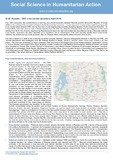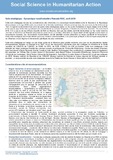Rwanda – DRC Cross Border Dynamics, April 2019
Note stratégique : Dynamique transfrontalière Rwanda-RDC, avril 2019
| dc.contributor.author | Bedford, Juliet | |
| dc.coverage.spatial | Democratic Republic of Congo | en |
| dc.date.accessioned | 2019-04-25T12:35:09Z | |
| dc.date.available | 2019-04-25T12:35:09Z | |
| dc.date.issued | 2019-04 | |
| dc.identifier.citation | Bedford, J. (2019) Rwanda – DRC Cross Border Dynamics, April 2019, UNICEF, IDS & Anthrologica | |
| dc.identifier.citation | Bedford, J. (2019) Note stratégique : Dynamique transfrontalière Rwanda-RDC, avril 2019, UNICEF, IDS & Anthrologica | |
| dc.identifier.uri | https://opendocs.ids.ac.uk/opendocs/handle/20.500.12413/14472 | |
| dc.description.abstract | This brief summarises key considerations concerning cross-border dynamics between Rwanda and the Democratic Republic of Congo (DRC) in the context of the outbreak of Ebola in North Kivu and Ituri provinces. It is the second in a series of four briefs focusing on the at risk border areas between DRC and the four high priority neighbouring countries (including Uganda, South Sudan and Burundi).1 As of April 2019, there had been no case of Ebola imported from the DRC into Rwanda, although alerts had been triggered on the roads leading from North Kivu towards neighbouring Rwanda and at least one high-risk contact was described as being a Rwandan national. Cross-border movement has been identified as a significant risk to transmission. This brief provides details about cross-border relations, the political and economic dynamics likely to influence these, and specific areas and actors most at risk. The brief is based on a rapid review of existing published and grey literature, previous ethnographic research in Rwanda and DRC, and informal discussions with colleagues from the Rwanda Ministry of Health, UNHCR, UNICEF, WHO, DFID, IOM, USAID, CDC and others. The brief was developed by Hugh Lamarque (The University of Edinburgh’s Social and Political Science Department - Centre for African Studies) with support from Ingrid Gercama, Emelie Yonally and Juliet Bedford (Anthrologica). Additional review and inputs were provided by Patricia Stys (London School of Economics), Jean-Benoît Falisse (University of Edinburgh), Benjamin Chemouni (University of Cambridge), David Peyton (Northwestern University), Papy Muzuri (London School of Economics) and colleagues from DFID (Rwanda Country Office) and UNICEF (Rwanda Country Office and East and Southern Africa Regional Office). The brief is the responsibility of the Social Science in Humanitarian Action Platform (SSHAP). | en |
| dc.description.abstract | Cette note stratégique résume les considérations clés inhérentes à la dynamique transfrontalière entre le Rwanda et la République démocratique du Congo (RDC) dans le contexte de la flambée épidémique d’Ébola survenue dans les provinces du Nord-Kivu et de l’Ituri. Il s’agit de la deuxième d’une série de quatre notes stratégiques axées sur les zones frontalières à risque situées entre la RDC et les quatre pays limitrophes constituant une priorité élevée (y compris l’Ouganda, le Soudan du Sud et le Burundi).1 Au mois d’avril 2019, il n’y a pas eu de cas d’Ébola importés de RDC au Rwanda, bien que des alertes aient été déclenchées sur les routes reliant la province du Nord-Kivu au Rwanda avoisinant et qu’au moins un contact présentant un risque élevé ait été signalé comme étant un ressortissant rwandais. Les mouvements transfrontaliers ont été identifiés comme présentant un risque significatif de transmission. Cette note stratégique fournit des détails quant aux relations transfrontalières, à la dynamique politique et économique susceptible de les influencer, et aux régions et intervenants spécifiques les plus vulnérables. Cette note stratégique est basée sur une étude rapide de la littérature grise publiée existante, ainsi que sur de précédentes études ethnographiques réalisées au Rwanda et en RDC, et sur des discussions informelles avec des collègues du ministère de la Santé rwandais, de l’UNHCR, de l’UNICEF, de l’OMS, du DFID, de l’OIM, d’USAID, du CDC et d’autres. Cette note stratégique a été élaborée par Hugh Lamarque (Faculté des sciences sociales et politiques de l’Université d’Édimbourg - Centre des études africaines) avec l’assistance d’Ingrid Gercama, Emelie Yonally et Juliet Bedford (Anthrologica). Des contributions supplémentaires ont également été apportées par Patricia Stys (London School of Economics), Jean-Benoît Falisse (Université d’Édimbourg), Benjamin Chemouni (Université de Cambridge), David Peyton (Université Northwestern), Papy Muzuri (London School of Economics) et par des collègues du DFID (Bureau national du Rwanda) et de l’UNICEF (Bureau national du Rwanda et bureau régional de l’Afrique orientale et australe). La responsabilité de cette note stratégique revient à la Plateforme Social Science in Humanitarian Action (SSHAP). | |
| dc.description.sponsorship | UNICEF | en |
| dc.language.iso | en | en |
| dc.publisher | UNICEF, IDS & Anthrologica | en |
| dc.rights.uri | http://creativecommons.org/licenses/by-nc/4.0/ | en |
| dc.subject | Health | en |
| dc.title | Rwanda – DRC Cross Border Dynamics, April 2019 | en |
| dc.title | Note stratégique : Dynamique transfrontalière Rwanda-RDC, avril 2019 | |
| dc.type | Series paper (non-IDS) | en |
| dc.rights.holder | Anthrologica | en |
| rioxxterms.funder | Default funder | en |
| rioxxterms.identifier.project | Default project | en |
| rioxxterms.version | VoR | en |
| rioxxterms.funder.project | 9ce4e4dc-26e9-4d78-96e9-15e4dcac0642 | en |



